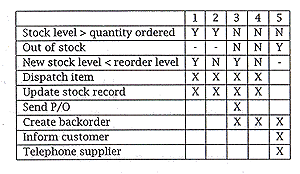| (a) | (i) List two benefits of prototyping. | [2] |
| (ii) List three actions which may be taken on the basis of the outcome of a prototype. | [3] | |
| (iii) Prototyping is traditionally used in the clarification of requirements. However, it can also be used as a helpful tool in other areas of a traditional methodology, such as systems development life cycle. Based on your understanding of these two types of model, described three ways in which prototyping can be incorporated into different stages of the systems development life cycle. | [6] | |
| (i) User Orientation : develop system that meets user needs to a greater extent. Fast development time : takes weeks or months as compared to the traditional approach which takes years. (ii) Implement prototype : prototype is a good system, meets user needs well and is placed in production. (iii) Prototyping is useful in
requirement determination stage as it helps both the developer and user to examine the
system request by using a prototype as a working model which it suppose to emulate the
actual system.
|
||
| (b) | The following describes the procedure carried
out by the stock control clerk in maintaining stock levels in a particular warehouse.
Develop a decision table to represent the above procedure. |
[9] |
|
